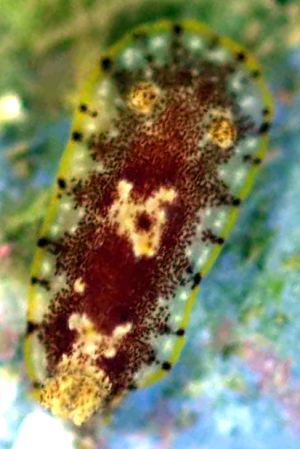

Aphelodoris antillensis
Bergh, 1879
Order: NUDIBRANCHIA
Suborder: DORIDINA
Superfamily: EUDORIDOIDEA
Family: Dorididae
DISTRIBUTION
Caribbean Sea
PHOTO
Upper: Lucaya, Grand Bahama Island, Bahamas, 1979. Photo: Lindsay Warren. Lower: Santa Marta (rocky shore), Colombia, Caribbean coast. 7 mm long alive, Photo: Nestor E. Ardila.
Originally described from a preserved specimen, Hamann (1992) described the colour variation to be found in this species. The background colour is translucent clear, and the viscera shows through in the central region as a pale orange or pinkish tinge. There rest of the mantle is covered with opaque white and dark brown spots, the dark brown spots often aggregated into larger patches. Around the mantle edge there a dark brown lines or linear patches arrange at right anles to the edge. In some specimens there is a yellow border. The translucent white body and foot also has dark brown spots. The white-tipped, lamellate rhinophores are yellowish, with a few spots of brown, and are able to retract into a raised sheath. The five thickened gills are also yellowish, becoming white at the tips, and are sparsely spotted with brown. grows to about 3cm in length.
Reference:
• Bergh, L. S. R. 1879. Neue Chromodoriden. Malakozoologische Blatter, NF 1: 87-116, pl. IV.
• Hamann, J.C. (1992) A warm water Atlantic synonymy, Aphelodoris antillensis equals Chromodoris bistellata (Opisthobranchia: Gastropoda). The Veliger, 35(3): 215-221.
• Marcus, Er., & Ev. Marcus. (1970) Opisthobranchs from Curacao and faunistically related regions. Studies on the fauna of Curacao and other Caribbean Islands, 33(122): 1-129.
• Redfern, C. (2001) Bahamian Seashells: A thousand species from Abaco, Bahamas. Bahamianseashells.com, Inc.: Boca Raton, Florida.
Rudman, W.B., 2003 (February 27) Aphelodoris antillensis Bergh, 1879. [In] Sea Slug Forum. Australian Museum, Sydney. Available from http://www.seaslugforum.net/factsheet/apheanti
Related messages
-
Aphelodoris antillensis from the Bahamas
From: Lindsay Warren, July 9, 2004 -
Aphelodoris antillensis from Colombia
From: Nestor E. Ardila, March 2, 2003
